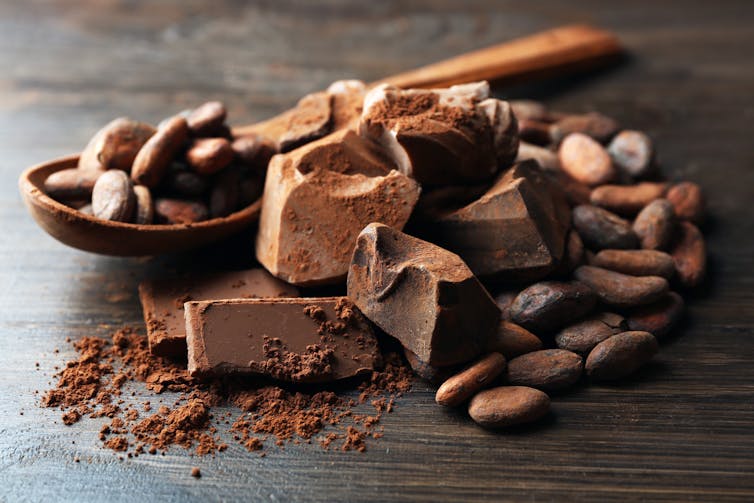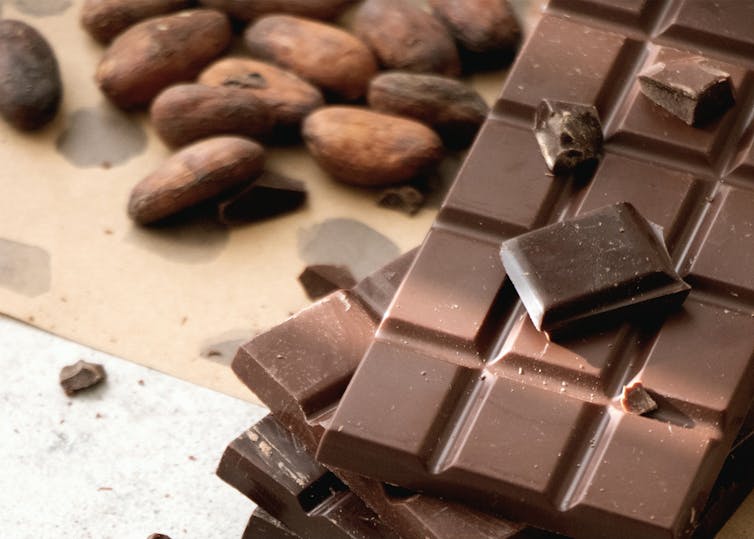By: Erin Alice Cowling, MacEwan University
We don’t generally think of chocolate as scary, despite its close ties to Halloween and all the miniature ghosts, skeletons and witches that will be out asking for a treat in lieu of a trick on Oct. 31. And even then, the threat of receiving a chocolate bar that has been tampered with is not enough to frighten most of us, and has been largely discredited as a hoax.
So, was there ever a time when chocolate was frightening? Not exactly. But there was a time when it was unknown outside of Mesoamerica.
As I relay in my book, Chocolate: How a New World Commodity Conquered Spanish Literature, its introduction into Europe generated concerns about the otherworldly nature of the drink, which was the only way it was consumed at the time.
When chocolate made its way to Europe
Spain was the first European country to import chocolate and there was growing alarm in the medical community about the drink and its potential side effects.
The origins of the drink in Latin America raised suspicion among both religious and medical professionals. From a European perspective, the lack of a recognizable religion on the continent meant that the inhabitants must have been under the influence of Satan. This misconception tainted anything coming out of the Americas.
Well-known satirist Francisco de Quevedo labelled tobacco and chocolate as demons sent to Spain to punish the colonial forces for the atrocities committed against Indigenous Peoples by making them weak and ill.
This was in line with medical practitioners of the period, who expressed concern that this new food from such a different climate could have a severe effect on the Spanish constitution. In the church, clergy complained that chocolate would break the fast, still an important part of Catholicism at the time.

(Shutterstock)
Anxieties around chocolate
Many of the anxieties around the uses of chocolate can be attributed to the preparation of the drink. While we now concern ourselves with the percentage of cacao in a chocolate bar, there were concerns then about the purity of the chocolate being sold.
In one instance, the Order of Doctors of Madrid blamed a string of unexpected deaths on the use of low-quality ingredients by chocolatiers who were facing supply-chain issues alongside increased demand. They then recommended that the court control the quality of imported chocolates, as well as restrict prices and regulate ingredients.
Seventeenth-century consumers not only had to concern themselves with quality issues, but also the threat of poisoning and witchcraft. It was common knowledge that the bitter taste and tendency to include spices and other ingredients made chocolate the perfect vehicle for hiding some of the more repulsive additives required to make potions.
Rumour had it that the last Hapsburg King, Carlos II (also known as “el hechizado” or “the cursed one”), was poisoned by his mother, by slipping some tissue from a dead man’s brain into his beloved cup of chocolate. Allegedly, this rendered him unable to lead or produce an heir, allowing her to continue to reign as his guardian. We now know that his issues were much more likely the outcome of generations of intermarriage.

(Tetiana Bykovets/Unsplash)
From mask for poison to cure all
Literary works that use chocolate as a theme also mention its magical powers; in one instance it is used as a sleeping potion, while elsewhere it is seen as a miracle cure.
In the play, Santa Rosa del Perú, a servant convinces the future Saint Rosa that chocolate is a better cure-all than anything you would find in a pharmacy. When they drink it, she recovers from a stomach-ache and he fixes a rotten tooth.
In the anonymous book The Great Sermon, chocolate is used in a variety of situations to cure foreign leaders in the hopes that they will be converted to Christianity.
In it, a Japanese king is cured of pain through chocolate, but instead of finding God, he becomes convinced of his sexual prowess and is sure that he will charm women of all ages, from virgins to widows. In another instance, a priest attempts to cure and baptize the leader of a region known as Tartary. The religious portion of the plan fails again, but the leader is miraculously cured through chocolate. The Great Sermon succeeds in demonstrating the ridiculous claims of the missionaries, thus criticizing Spain’s use of religion to justify the destruction and colonization of Latin America.
Chocolate’s trajectory from Mesoamerica to Spain was not direct or smooth, but ultimately chocolate has survived and thrived in European and American societies. Despite the early connections to witchcraft, chocolate quickly becomes tied to a different kind of magic, that of the miracle.
Ultimately, chocolate is incorporated into the daily diet of Spain and continues to be an important part of the cultural and culinary legacy on both sides of the Atlantic.
Erin Alice Cowling is an Associate Professor of Spanish, Department of Humanities, at MacEwan University
This article is republished from The Conversation under a Creative Commons license.

